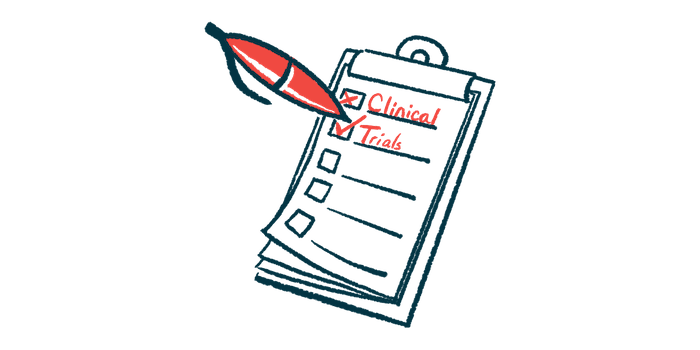Esketamine treatment eases some Rett symptoms in small clinical trial
Molecule related to ketamine shows promise in 2 of 3 girls, ages 9-10

Treatment with esketamine — a molecule chemically related to the dissociative anesthetic ketamine — has the potential to ease the symptoms of Rett syndrome, according to researchers in China who led a small clinical trial that enrolled three young girls with the progressive condition.
The pilot study involved two 10-year-olds and a 9-year-old, all of whom had mood issues, stereotypic hand behaviors, and limitations on the functional use of their hands.
After receiving the treatment, which was generally well tolerated, improvements in mood and hand behaviors among the girls were noted by both clinicians and caregivers.
“Additionally,” the researchers wrote, “we found that two patients pushed away food that they did not like, touched their parents’ faces, or held food with their hands after dosing … behaviors that had not been observed in years.”
According to the team, “this pilot study highlights the potential of esketamine treatment for improving behavioral dysfunction in patients with [Rett].”
The study, “Intravenous esketamine in pediatric Rett syndrome: An open-label, early phase 1 pilot study,” was published in the journal Molecular Therapy: Methods & Clinical Development.
Pilot study evaluated esketamine treatment in children in China
Rett syndrome is a rare neurodevelopmental condition characterized by a wide range of symptoms that include behavioral issues, motor problems, autism-like features, and seizures.
Ketamine, a hallucinogenic compound that causes a feeling of detachment from one’s surroundings, has been used as an anesthetic agent for decades. Esketamine is a chemically related molecule with similar properties. Both compounds block the activity of NMDA receptors, which mediate the effects of a brain-signaling chemical called glutamate.
Increasingly, low doses of ketamine or esketamine — less than what’s needed to induce anesthesia — are being explored as a possible treatment for various neuropsychiatric conditions. Esketamine is already approved in the U.S. as a nasal spray formulation under the brand name Spravato for treating depression.
Studies have shown evidence of abnormal NMDA receptor levels and glutamate signaling in the Rett brain. In preclinical studies, ketamine was found to restore more normal brain signaling and ease Rett symptoms in mice. Those findings had supported the idea that ketamine-related compounds could be of benefit for Rett patients.
However, newly published results from a Phase 2 clinical trial (NCT03633058) in the U.S. showed that oral ketamine, while well tolerated, was not effective for easing Rett symptoms.
In this report, the scientists described findings from a small Phase 1 pilot study (NCT06199700) conducted in China. It had tested the feasibility of esketamine treatment in three girls with Rett syndrome, who were all 9-10 years old at enrollment. The girls received five weekly esketamine infusions into the bloodstream (0.25 mg/kg).
Esketamine’s efficacy was evaluated via several Rett-related questionnaires completed by caregivers and clinicians on a weekly basis. Brain activity was evaluated with video electroencephalogram (VEEG) before and after each infusion.
Across the three participants, the questionnaire results generally indicated clinical improvements. At the end of treatment, the clinicians rated the patients, on average, as exhibiting minimal improvements in overall clinical status.
2 of the 3 patients showed improvements in mood, behavior
Additionally, the results of other caregiver-reported measures, including the Rett Syndrome Behavior Questionnaire and the Revised Motor Behaviors Assessment Scale, tended to indicate reductions in Rett symptoms.
However, there was substantial variability in outcomes on the individual level. Two of the patients generally showed clinical improvements with esketamine treatment but the third did not respond, according to the researchers.
Accordingly, VEEG findings indicated that the two patients who showed a clinical response also exhibited improvements in the posterior dominant rhythm — a pattern of brain activity that happens when a person is awake but relaxed with their eyes closed. This rhythm is commonly found to be irregular in Rett patients.
Esketamine was not associated with improvements in sleep habits, reductions in symptoms of autism spectrum disorder, or a change in developmental status for any of the girls, the data showed.
The researchers indicated, however, that they observed other improvements in mood and behavior.
The team noted that the patients “smiled more and paid more attention to other people” after the infusions. Hand stereotyping, a Rett symptom characterized by repetitive hand movements, stopped during the infusions, which was usually maintained for an hour or two after dosing. The frequency of hand stereotyping was reduced after multiple infusions.
Patients also exhibited positive behaviors in terms of hand function that their caregivers had not observed for years, including holding a parent’s hands.
“Before the trial, the father needed to hold the patient’s hands,” the researchers wrote.
This pilot study provides valuable information for further investigating regarding the potential of low-dose esketamine treatment for improving behavioral dysfunction in patients with [Rett].
The esketamine infusions were generally well tolerated, and no severe side effects occurred. Two patients experienced temporary nausea during infusions, and the third showed signs of irritability that may have been nausea-related, per the authors.
The girls were generally able to eat and be as active as usual approximately one hour after each infusion.
Although only a small number of patients were enrolled — the parents of three other girls decline to have their child participate “due to concerns regarding the trial’s risks” — the researchers note the outcomes were positive overall.
“This pilot study provides valuable information for further investigating regarding the potential of low-dose esketamine treatment for improving behavioral dysfunction in patients with [Rett],” the team wrote.
The scientists indicated that investigating different dosages and formulations, such as nasal sprays, might “enhance its beneficial effects in [Rett patients] with fewer undesirable features.”








